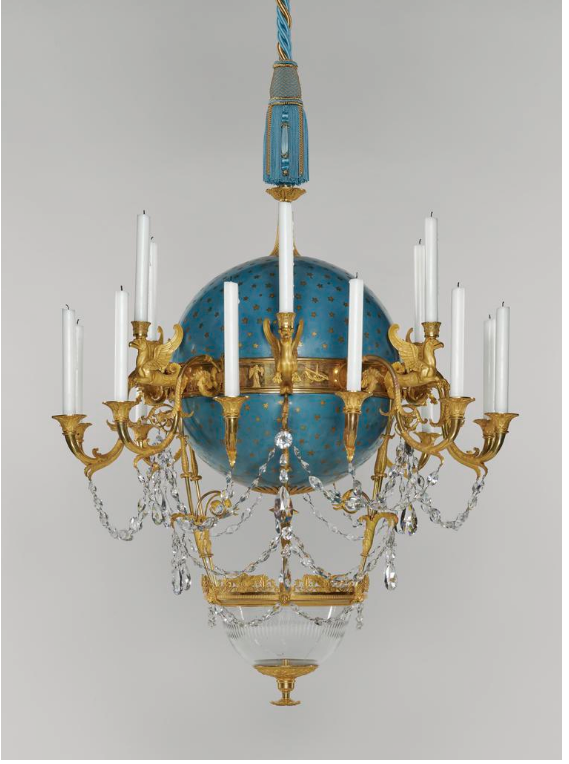The Iconic Galle Chandelier Gets a Closeup at Getty
 Chandelier, about 1818–1819, Gilt bronze; glass; painted
Chandelier, about 1818–1819, Gilt bronze; glass; painted copper; gilt tin, iron armature, by Gérard Jean Galle.
Courtesy of The J. Paul Getty Museum, Los Angeles.
The J. Paul Getty Museum’s iconic Galle Chandelier is getting a show of its own. For years, viewers have marveled at the whimsical bronze and copper rotating chandelier, a stellar example of art ahead of its time. For decades, the extraordinary Galle Chandelier has long stood out as a highlight of the Los Angeles museum's decorative arts collection.
Flight of Fancy: The Galle Chandelier is a special, year-long display of the chandelier that allows visitors to see one of the Getty’s most beloved objects in a new light.
Created by French bronze caster and gilder Gérard Jean Galle in 1818, the chandelier is a work of extreme novelty that includes a glass bowl intended to hold water and small goldfish and eighteen candles whose flames would illuminate a room after dark. This elaborate example of sculpture has become a signature piece at the Getty, and viewers are excited to take a closer look.
Although created in the early 19th Century, the balloon-like centerpiece resembles a more modern era. Other aspects of the chandelier conjure up the four elements: plant motifs (earth), candle flames (fire), the bowl (water), and flying griffins (air).
Acquired by J. Paul Getty in 1973, the Chandelier has been on permanent display at the Getty Center since it opened in 1997. After being de-installed early this year for conservation, photography, and study, the new exhibition encourages close viewing of the chandelier and explores the inspiration, sources, and themes of its imaginative design. The chandelier is displayed at eye-level, allowing visitors to examine the intricate bronze and copper details more closely. Also on view are prints from the collection of the Getty Research Institute that illustrate sources of inspiration for the artist. Didactic panels and close-up photographs illustrate the chandelier’s details. An accompanying interactive video allows visitors to see what the chandelier lit up and in-motion.
According to Jeffrey Weaver, associate curator for sculpture and decorative arts at the Getty Museum, Jean Galle created the continuous movement of fish in the water to amuse viewers. This idea reflected a design theory of the early 1800s that suggested objects should be not only functional but also gratifying to the eye and the imagination. Representing the heavens, the blue globe at the center of the chandelier has gilt stars and is encircled by a gilt-bronze band bearing the twelve symbols of the zodiac.
Galle’s roots bronze caster led him on this path. Before becoming a sculptor, he designed and made luxury items in gilt bronze such as clock cases, candelabra, chandeliers, and vases. He exhibited a number of pieces at the Paris Exhibition of French Products of Industry in 1819. He then wrote to the government of King Louis XVIII, offering the works for sale and providing detailed descriptions of each. These included a chandelier of the same design displayed at the Getty
Unfortunately, Galle was not successful in his appeal to sell the chandelier to Louis XVIII and struggled with financial difficulties throughout his lifetime, but he did not give up. He continued to produce high-quality objects in gilt bronze and was awarded a gold medal at the Paris Exhibition of 1823.
Resources:
Also in this Issue:
- Garage Sale Bronze Statue Featured on Antiques Roadshow Sells at Sotheby’s for $2.1 Million
- Exploring the Deep and Widespread Roots Of Folk Art in NYC
- The Iconic Galle Chandelier Gets a Closeup at Getty
- Evoking the Power of Nature in Bronze
- MOMA Announces 2020 Donald Judd Retrospective
